India’s East Coast has had an enduring connection to the ocean, dating back to the 3rd Millennium BC. Maritime traffic, from this region, has spread Hinduism as far away as Indonesia, and Buddhism to Thailand and beyond. India’s most ancient text, the Rig Veda, chronicles India’s earliest maritime activity to 1700 BC whereas the Buddhist Jatakas relate ocean travel back to 500 BC. Many residents of Visakhapatnam believe that the city was just a fishing village that grew into a city only after the English set up their trading post here in 1682 AD. But is there an untold story of the origins of Visakhapatnam? For the reconstruction of the lost history of Visakhapatnam, stone or copper inscriptions can be relied upon as an authentic source.
The first recorded history of a place by the name “Visakhapatnam” can be seen on a stone inscription inside the Lord Bhimeswara Swamy Temple in Draksharamam (in present-day East Godavari District, Andhra Pradesh). A text of that inscription as recorded and published by the Government Epigraphical branch of the Archaeological Survey of India (ASI) is reproduced in Fig 1.
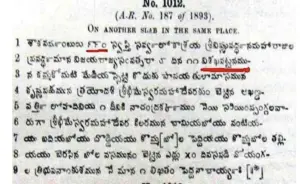
This inscription reads – ‘in the year Saka 990 (which corresponds to 1068 AD) a merchant by the name Papaya, son of Mediya setti from Visakhapatnam, made a donation to ‘Bhimeswara’, the presiding deity of that temple. The donation consisted of one metal lamp stand for lighting a lamp. He also donated 50 cows for the supply of ghee to light that lamp to burn perpetually as long as the Sun and Moon last.’
This inscription provides the first recorded history of the city of Visakhapatnam being in existence by the year 1068 AD. We have no recorded evidence to show how long it was in existence before 1068 AD. Today, with historical evidence, we can confidently say that Visakhapatnam is more than 1000 years old, and that merchants were residing here and also, there was sufficient trade for them in the coastal town.
There are some inscriptions found within the town of Visakhapatnam and in Simhachalam temple, giving some more historical evidence.
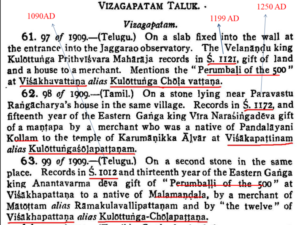
Examining the other inscription against serial no. 61 in fig 2, it also refers to thea sale of a land and a house to a merchant in Visakhapatnam in the year 1199 AD. This inscription also mentions the merchant guild. The name of Kulottunga Chola Pattana continues to be applied to Visakhapatnam for about two hundred years.
The inscription, showed against serial no. 62 in fig 2 in Tamil, mentions a gift of a mantapa to a temple by a merchant in the year 1250 AD. This inscription gives new information onf the existence of a temple, called “Karumanikka Alvar”, in Visakhapatnam. This is the only inscription available about this temple and there is no evidence of it in any literary sources. It was recorded in the Epigraphical report of the year 1909 AD that the inscriptions of AD 1199 and AD 1250 were found near Paravastu Rangacharya’s house. Paravastu Rangacharya’s family were living in Kancheraveedi of the old town near Venkateswara Temple (Embermannar). In all probability, this Karumanikka Alwar temple might have been in the old town of Visakhapatnam. Kollam, in this inscription, refers to the Port of Kollam near the present Kozikode in Kerala.
The inscription against serial no. 63 in the above figure relates to the period of Anantavarman Chodaganga Deva, a Eastern Ganga King related to Kulottunga I, inscribed in the Saka year 1012, corresponding to 1090-91 AD. “Perumballi of the 500” refers to a merchant guild of the Anjuvannam Group, hailing from Malamandala (Kerala). So, the inscription records a gift by the guild to a merchant of Kerala. This gives evidence that there were merchant guilds, and merchants from Kerala, at Visakhapatnam during the 11th Century. It also says that the name of the city was changed as Kulottunga-Cholapattana in honour of the king of the Chola dynasty, which was ruling Chola, Vengi and Kalinga areas at that time.
The three inscriptions in Fig 2, mention merchants of trade guilds residing in Visakhapatnam. Considerable history of maritime trade in Visakhapatnam during the period between 1099 AD and 1250 AD. It is also clear that there was much Tamil influence in Visakhapatnam during Chalukya Chola’s time.
There is another inscription in Fig. 3 wherein Visakhapatnam is mentioned. This is one of the many inscriptions at the Simhachalam Temple.
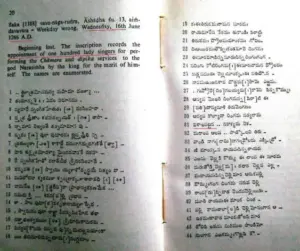
It mentions King Vira Narasimha Deva appointing about one hundred lady singers for services at the temple in the year 1266 AD. It also gives out a list of those singers, some of whom were from Visakhapatnam. From this, it is evident that artists were also residing in the town during that period.
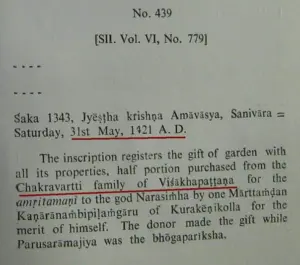
One more inscription given in Fig. 4 is also from the Simhachalam Temple wherein it is mentioned that a person, who appears to be Tamil, purchased a garden from a local resident of Visakhapatnam and gifted it to the temple in the year 1421 AD. This gives evidence of an agrarian society in Visakhapatnam.
In summary, the inscriptions above indicate that Visakhapatnam has a long history – at least a thousand years of recorded history. It was a port with thriving trade with overseas countries. The social fabric of the city’s society consisted of trading community, community of artist, agrarian community etc., and not just a fishing community; much before the East India Company set up their establishment here in 1682 AD.
Regarding the name of the city, it was known as Visakhapatnam for more than 1000 years. As per the inscriptions mentioned above, although the name was changed as Kulottunga Chola Pattanam for about 200 years, it still retained its original name of Visakhapatnam after the influence of the Cholas faded.
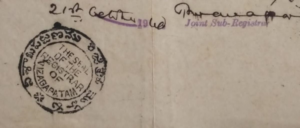
During the British period they called the city Vizagapatam. The British could not pronounce the Telugu word “Visakhapatnam”. In their accent, they pronounced it as Vizagapatam and spelled the word as they pronounced it. In English slang, it became easier to say Vizag!
As can be seen from the above image (Fig. 5), the official records of the British spell the city name as Vizagapatam in English, but in Telugu, it was mentioned as Visakhapatnam. After India’s Independence, sometime before 1953, the name “Vizagapatam” was officially changed to Visakhapatnam.
This article is a part of a nautical series, being published by Yo! Vizag to honour the commissioning of INS Visakhapatnam.
The above-mentioned facts and images have been provided by Vijjeswarapu Edward Paul, a city-based History Researcher. A retired Shipping Manager by profession, the septuagenarian, belying his age, has been collecting data on Vizag from British Library, London, Tamil Nadu Govt. Archives, Christian Theological college Archives at Bangalore and Hyderabad, and other public libraries.


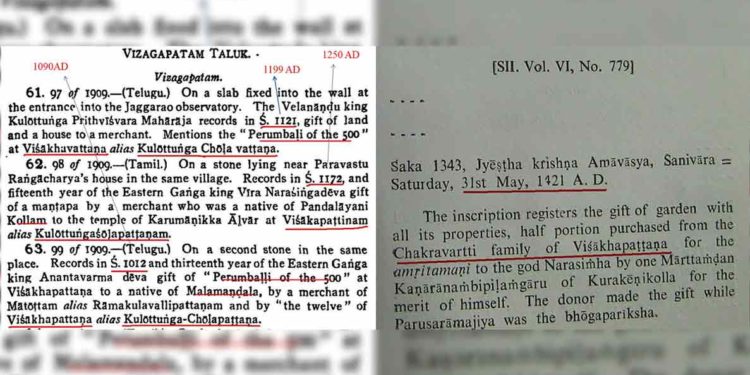







Discussion about this post